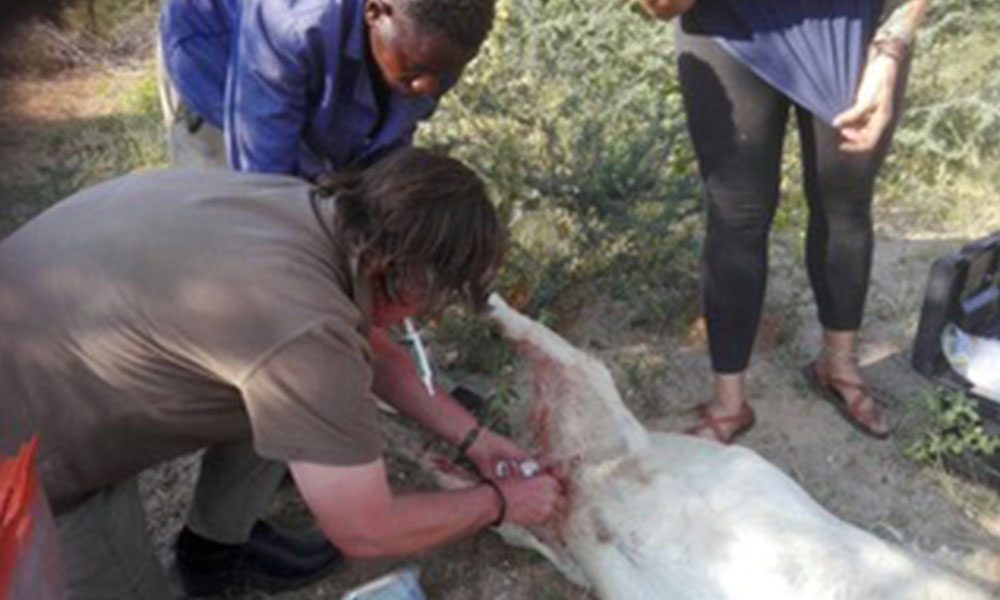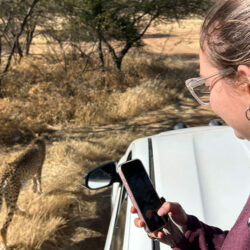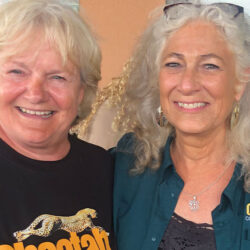My Time at CCF – Working Guest Monique Kuypers
-

- by Monique Kuypers May 10, 2018

My name is Monique Kuypers and I am an equine vet from the Netherlands on a 6 month sabbatical as a working guest from the University of Dronten, where I teach a degree course: Equine Business Management. I came in contact with CCF in 2008 when I assisted with the release of five male cheetahs in the Namib Rand reserve in the south west of Namibia. In July 2016 I returned to Namibia and CCF and continued to volunteer as a working guest vet in the different departments of CCF.
The first time I came to Africa I felt at home. I came to CCF because I feel the same about conserving the biodiversity as in the mission of CCF. I think it would be a huge loss if more species would disappear and if I can help to prevent that I am willing to do that. I approve of the strategy of conserving ecosystems instead of individual species.
One of the areas that CCF has worked in for over 25 years is in the Otjozondjupa communal conservancies which is part of the Greater Waterberg Landscape, where communal farmers, freehold farmers and the Waterberg National Park combine efforts in the management of their livestock farming and wildlife management has been a program I became very interested in when I learned about it. This approach is a new concept to me and an aspect I have been interested in following CCFs work since I first came here.
What triggered me was the holistic structure of this project.

- Livelihood of the Herero people
- Balanced and sustainable farm management
- Making space for an increase of wildlife population
- Balanced ecosystem
For my current time here I have been assigned as a support research vet given my experience in livestock management and disease. I have been assigned to the team who are currently conducting research on wildlife presence in the Otjozonjupa communal conservancies and so every second week I join them in the field.
At this moment we are in the field visiting farmers and doing surveys about the farm management, animal health etc. Arriving at a homestead each of us will have a job to do. Nadja le Roux will explain what the reason of our visit is and what we would like to accomplish. Her role as Community Development Manager is very multifaceted with a deep understanding of issues that communal and subsistent farmers have with predator and livestock conflict as well as the struggles farmers have in bettering their livelihoods. She will spend time talking and consulting with farmers about their roles in balancing their ecosystems, the benefits of wildlife and how integrated plans can start being developed to find the balance for the future.
Willem Briers-Louw is CCFs resident Ecologist who is researching wildlife presence in the area. The Otjozondjupa communal land has been extremely overgrazed and has a very low wildlife population which has a very negative impact on the area. His study will help CCF to understand what key prey species are in the area, as well as carnivores. Willem spends time with the residents, generally the “workers” who have knowledge on where wildlife might be passing by on their land and will then go out with individuals to track and determine the best site to place a camera trap where wildlife are likely to move.
I am collecting fecal samples of livestock to determine what parasites the livestock might be carrying to see how high the contamination of endoparasites is and I conduct surveys on what kind of health management is practiced on the farm. To reach CCFs goal of a more integrated farming approach which can secure habitat and increase wildlife numbers while reducing conflict with predators all the different roles within this team are important.
I am learning first hand about CCFs ethos in communal farms by using grass root approaches to encourage, motivate and showcase to farmers what the benefits are of more wildlife on the land. To increase the productivity of the land, livestock and wildlife a very important part is improving the management and health of the livestock, which are the main source of livelihood for the people living there. Predation loss will always exist, but the tolerance level of the farmers to this loss will increase if the livelihood increases.
The dry season is a difficult time for the Herero farmers. The offspring of the livestock are the moneymakers for the Herero farmers, however calves, lambs and kids are also potential prey for the predators and young livestock must be kept safe when they are vulnerable. Some farmers have livestock guarding dogs, often these are small feisty mongrels that go to pasture with the small livestock. Other farmers will keep the young stock in the kraal up to an age of a few months. The differences are big on this management subject but overall can be concluded: the more attention it gets, the less losses are seen.
Coming out in the field to the farms is very exciting, seeing how pastoral farming works how the Herero people live and of course living outside in the Namibian countryside. Enjoying nature, learning the different types of birds of prey and the huge variety on snakes. Willem has competent tracking skills and has been teaching me the tracks of the different animals which is fascinating and exciting, using skills of following vultures and then finding a carcass they are feeding from have all been highlights for me.
And the of-course, the beautiful starlight nights with a concert of sand frogs or pearl spotted owls at our camp at night always ends off a great day.
Related Reading
-
October 20, 2025
How Do You Outrun Extinction? -
October 17, 2025
Two CCF Trips – Eastern and Southern Africa




